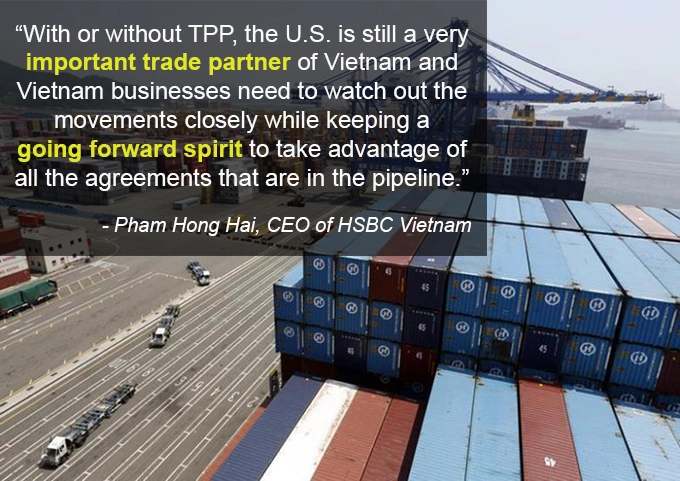Edition: International | Vietnamese
© Copyright 1997 VnExpress.net. All rights reserved.
U.S. President-elect Donald Trump has recently vowed to kill the Trans-Pacific Partnership, which he once called "the worst trade deal ever, a fiasco."
So what is going to happen to Vietnam?
Many said Vietnam would probably be the top winner if TPP, a mammoth free trade agreement whose 12 members comprise nearly 40 percent of global GDP, is ratified, as a result of the country's strong trade tie with the U.S. In the first 11 months, Vietnam posted a trade surplus of $27 billion with the U.S., according to official data. Exports hit $34.7 billion, up 14 percent.
Key exports including agro-products, fisheries, garments and textiles and electronic products would enjoy a zero tariff rate. Thanks to TPP, investment to Vietnam could reach $35 billion compared to $23 billion in 2015, according to a report of Singaporean consulting firm Solidance.
But TPP may never happen.
Not long after Trump's win, the National Assembly, Vietnam's legislature, decided to shelve ratification of the trade pact.
Stephen Wyatt, Country Head of the global real estate advisor JLL, believed investment inflows could be affected. He said that without TPP, investment in Vietnam may witness a sharp fall.
With Trump's decision, the Chinese-backed Regional Comprehensive Economic Partnership (RCEP) becomes a second option for Vietnam. Together with the U.S., China is among the biggest trade partners of the country.
Analysts warned that for Vietnam, being a part of RECP is a double-edged sword as the reliance on trading with China would be intensified.
But Vietnam also has other free trade agreements (FTAs) going on. With or without TPP, Vietnam will likely continue opening up its economy to the world.

Vietnam posted $7.7 billion in bilateral trade with Australia and became Australia’s fastest growing trade partner in Southeast Asia in 2015, as a result of the ASEAN Australia New Zealand free trade agreement (AANZFTA).
The recently finalized trade agreement between E.U. and Vietnam (EVFTA), which will take effect in 2018, is another example. The EVFTA is considered a key to unlock the potential market of Vietnamese agricultural products. Once it is implemented, over 99 percent of the tariffs will be eliminated.

Jeff Kingston, Director of Asian Studies at Temple University Japan, said Trump’s withdrawal from TPP is "a boon for China and an erosion of U.S. influence in Asia."
But will Trump change his mind?
“Probably not, Trump seems to stick to his gun,” Thomas Jandl, Non-Resident Scholar at Vietnam National University told VnExpress International.
As currently structured, the trade deal can only come into force when six countries accounting for 85 percent of the group's GDP ratify the agreement, meaning TPP can only be alive if it is ratified by the U.S.
Technically, the TPP is not really dead, but...

If the TPP cannot make it, are there any options?
The China led-RCEP, which includes 10 Southeast Asian countries of ASEAN, as well as China, India, Japan, South Korea, Australia and New Zealand, would be a good alternative not only for Vietnam but also for other Asian countries.
It should be noted that over a third of RCEP member are also a part of the TPP and that this China-led free trade does not include the world’s largest economy.
> Vietnam PM backs off from US-led TPP, emphasizes independent foreign policy
> Vietnam says economy will still thrive even if TPP tanks
> TPP to give foreign investors power to sue Vietnamese government